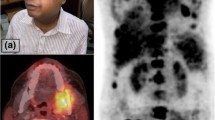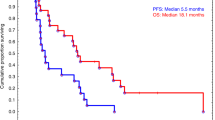Abstract
Plasmacytoma has been reported to be associated with a poor prognosis in patients with multiple myeloma (MM). In this study, we evaluated the incidence of relapse with plasmacytoma and survival outcomes after upfront autologous stem cell transplantation (ASCT). This study retrospectively analyzed the data of 303 patients with MM who underwent upfront ASCT between April 2000 and April 2018 at eight institutes in the Republic of Korea. In total, 52 patients (17.1%) had plasmacytoma at MM relapse after upfront ASCT, of whom, 27 had paramedullary plasmacytoma (PMD) and 25 had extramedullary plasmacytoma (EMD). Patients with initial plasmacytoma were more likely to have plasmacytoma at MM relapse than those without initial plasmacytoma (37.1% vs. 11.2%). Over a median follow-up of 66.0 months, patients with plasmacytoma at relapse had significantly inferior overall survival (OS) than those without plasmacytoma (43.9 vs. 100.7 months, P < 0.001), but the OS did not significantly differ between patients with EMD and those with PMD (42.2 vs. 56.6 months, P = 0.464). After MM relapse, all patients received salvage therapy, and progression-free survival after relapse was significantly shorter in patients with plasmacytoma than in those without (6.4 vs. 12.4 months, P = 0.007). This study showed that plasmacytoma frequently developed at MM relapse after upfront ASCT in patients with plasmacytoma at the time of diagnosis. Plasmacytoma at relapse was significantly associated with a poor prognosis.



Similar content being viewed by others
Data availability
The dataset is available from the corresponding author upon reasonable request.
Change history
23 May 2022
A Correction to this paper has been published: https://doi.org/10.1007/s00277-022-04854-3
References
Siegel RL, Miller KD, Jemal A (2020) Cancer statistics, 2020. CA Cancer J Clin 70(1):7–30
Rajkumar SV, Dimopoulos MA, Palumbo A, Blade J, Merlini G, Mateos MV, Kumar S, Hillengass J, Kastritis E, Richardson P et al (2014) International Myeloma Working Group updated criteria for the diagnosis of multiple myeloma. Lancet Oncol 15(12):e538-548
Palumbo A, Anderson K (2011) Multiple myeloma. N Engl J Med 364(11):1046–1060
Beksac M, Seval GC, Kanellias N, Coriu D, Rosinol L, Ozet G, Goranova-Marinova V, Unal A, Bila J, Ozsan H et al (2020) A real world multicenter retrospective study on extramedullary disease from Balkan Myeloma Study Group and Barcelona University: analysis of parameters that improve outcome. Haematologica 105(1):201–208
Blade J, de Larrea CF, Rosinol L (2012) Extramedullary involvement in multiple myeloma. Haematologica 97(11):1618–1619
Touzeau C, Moreau P (2016) How I treat extramedullary myeloma. Blood 127(8):971–976
Rosinol L, Beksac M, Zamagni E, Van de Donk N, Anderson KC, Badros A, Caers J, Cavo M, Dimopoulos MA, Dispenzieri A et al (2021) Expert review on soft-tissue plasmacytomas in multiple myeloma: definition, disease assessment and treatment considerations. Br J Haematol 194(3):496–507
Dahl IM, Rasmussen T, Kauric G, Husebekk A (2002) Differential expression of CD56 and CD44 in the evolution of extramedullary myeloma. Br J Haematol 116(2):273–277
Roccaro AM, Mishima Y, Sacco A, Moschetta M, Tai YT, Shi J, Zhang Y, Reagan MR, Huynh D, Kawano Y et al (2015) CXCR4 regulates extra-medullary myeloma through epithelial-mesenchymal-transition-like transcriptional activation. Cell Rep 12(4):622–635
Bhutani M, Foureau DM, Atrash S, Voorhees PM, Usmani SZ (2020) Extramedullary multiple myeloma. Leukemia 34(1):1–20
Blade J, de Fernandez Larrea C, Rosinol L, Cibeira MT, Jimenez R (2011) Powles R Soft-tissue plasmacytomas in multiple myeloma incidence mechanisms of extramedullary spread and treatment approach. J Clin Oncol 29(28):3805–3812
Pour L, Sevcikova S, Greslikova H, Kupska R, Majkova P, Zahradova L, Sandecka V, Adam Z, Krejci M, Kuglik P et al (2014) Soft-tissue extramedullary multiple myeloma prognosis is significantly worse in comparison to bone-related extramedullary relapse. Haematologica 99(2):360–364
Usmani SZ, Heuck C, Mitchell A, Szymonifka J, Nair B, Hoering A, Alsayed Y, Waheed S, Haider S, Restrepo A et al (2012) Extramedullary disease portends poor prognosis in multiple myeloma and is over-represented in high-risk disease even in the era of novel agents. Haematologica 97(11):1761–1767
Short KD, Rajkumar SV, Larson D, Buadi F, Hayman S, Dispenzieri A, Gertz M, Kumar S, Mikhael J, Roy V et al (2011) Incidence of extramedullary disease in patients with multiple myeloma in the era of novel therapy, and the activity of pomalidomide on extramedullary myeloma. Leukemia 25(6):906–908
Palumbo A, Avet-Loiseau H, Oliva S, Lokhorst HM, Goldschmidt H, Rosinol L, Richardson P, Caltagirone S, Lahuerta JJ, Facon T et al (2015) Revised international staging system for multiple myeloma: a report from International Myeloma Working Group. J Clin Oncol 33(26):2863–2869
Cavo M, Gay F, Beksac M, Pantani L, Petrucci MT, Dimopoulos MA, Dozza L, van der Holt B, Zweegman S, Oliva S et al (2020) Autologous haematopoietic stem-cell transplantation versus bortezomib-melphalan-prednisone, with or without bortezomib-lenalidomide-dexamethasone consolidation therapy, and lenalidomide maintenance for newly diagnosed multiple myeloma (EMN02/HO95): a multicentre, randomised, open-label, phase 3 study. Lancet Haematol 7(6):e456–e468
Lee SE, Kim JH, Jeon YW, Yoon JH, Shin SH, Eom KS, Kim YJ, Kim HJ, Lee S, Cho SG et al (2015) Impact of extramedullary plasmacytomas on outcomes according to treatment approach in newly diagnosed symptomatic multiple myeloma. Ann Hematol 94(3):445–452
Montefusco V, Gay F, Spada S, De Paoli L, Di Raimondo F, Ribolla R, Musolino C, Patriarca F, Musto P, Galieni P et al (2020) Outcome of paraosseous extra-medullary disease in newly diagnosed multiple myeloma patients treated with new drugs. Haematologica 105(1):193–200
de Fernandez Larrea C, Jimenez R, Rosinol L, Gine E, Tovar N, Cibeira MT, Fernandez-Aviles F, Martinez C, Rovira M, Blade J (2014) Pattern of relapse and progression after autologous SCT as upfront treatment for multiple myeloma. Bone Marrow Transplant 49(2):223–227
Kumar L, Gogi R, Patel AK, Mookerjee A, Sahoo RK, Malik PS, Sharma A, Thulkar S, Kumar R, Biswas A et al (2017) Multiple myeloma with extramedullary disease: impact of autologous stem cell transplantation on outcome. Bone Marrow Transplant 52(10):1473–1475
Attal M, Richardson PG, Rajkumar SV, San-Miguel J, Beksac M, Spicka I, Leleu X, Schjesvold F, Moreau P, Dimopoulos MA et al (2019) Isatuximab plus pomalidomide and low-dose dexamethasone versus pomalidomide and low-dose dexamethasone in patients with relapsed and refractory multiple myeloma (ICARIA-MM): a randomised, multicentre, open-label, phase 3 study. Lancet 394(10214):2096–2107
Palumbo A, Chanan-Khan A, Weisel K, Nooka AK, Masszi T, Beksac M, Spicka I, Hungria V, Munder M, Mateos MV et al (2016) Daratumumab, bortezomib, and dexamethasone for multiple myeloma. N Engl J Med 375(8):754–766
Dimopoulos MA, Oriol A, Nahi H, San-Miguel J, Bahlis NJ, Usmani SZ, Rabin N, Orlowski RZ, Komarnicki M, Suzuki K et al (2016) Daratumumab, lenalidomide, and dexamethasone for multiple myeloma. N Engl J Med 375(14):1319–1331
Jelinek T, Sevcikova T, Zihala D, Popkova T, Kapustova V, Broskevicova L, Capkova L, Rihova L, Bezdekova R, Sevcikova S et al (2021) Limited efficacy of daratumumab in multiple myeloma with extramedullary disease. Leukemia 36(1):288–291
Raje N, Berdeja J, Lin Y, Siegel D, Jagannath S, Madduri D, Liedtke M, Rosenblatt J, Maus MV, Turka A et al (2019) Anti-BCMA CAR T-cell therapy bb2121 in relapsed or refractory multiple myeloma. N Engl J Med 380(18):1726–1737
Yan Z, Cao J, Cheng H, Qiao J, Zhang H, Wang Y, Shi M, Lan J, Fei X, Jin L et al (2019) A combination of humanised anti-CD19 and anti-BCMA CAR T cells in patients with relapsed or refractory multiple myeloma: a single-arm, phase 2 trial. Lancet Haematol 6(10):e521–e529
Thangaraj JL, Ahn SY, Jung SH, Vo MC, Chu TH, Thi Phan MT, Kwon M, Lee KH, Kim M, Song GY et al (2021) Expanded natural killer cells augment the antimyeloma effect of daratumumab, bortezomib, and dexamethasone in a mouse model. Cell Mol Immunol 18(7):1652–1661
Vo MC, Yang S, Jung SH, Chu TH, Lee HJ, Lakshmi TJ, Park HS, Kim HJ, Lee JJ (2018) Synergistic antimyeloma activity of dendritic cells and pomalidomide in a murine myeloma model. Front Immunol 9:1798
Vo MC, Jung SH, Chu TH, Lee HJ, Lakshmi TJ, Park HS, Kim HJ, Rhee JH, Lee JJ (2018) Lenalidomide and programmed death-1 blockade synergistically enhances the effects of dendritic cell vaccination in a model of murine myeloma. Front Immunol 9:1370
Chu TH, Vo MC, Park HS, Lakshmi TJ, Jung SH, Kim HJ, Lee JJ (2021) Potent anti-myeloma efficacy of dendritic cell therapy in combination with pomalidomide and programmed death-ligand 1 blockade in a preclinical model of multiple myeloma. Cancer Immunol Immunother 70(1):31–45
Author information
Authors and Affiliations
Contributions
CKM and JJL designed the study and THC and SHJ prepared the manuscript; KK, JHL, YCM, SMB, DHY, and HSL critically reviewed the manuscript. All authors have read and approved the final manuscript.
Corresponding authors
Ethics declarations
Ethics approval and consent to participate
This retrospective study was approved by the institutional ethics committee of each participating institution and conducted in accordance with the Declaration of Helsinki. The committee waived the need for informed patient consent because of the retrospective nature of the work.
Consent for publication
Not applicable.
Competing interests
The authors declare no competing interests.
Additional information
Publisher's Note
Springer Nature remains neutral with regard to jurisdictional claims in published maps and institutional affiliations.
The original version of this article was revised: In published article, the sentence "Please present P values consistently" was inadvertently included in the beginning of the abstract section.
Supplementary Information
Below is the link to the electronic supplementary material.
Rights and permissions
About this article
Cite this article
Chu, TH., Jung, SH., Kim, K. et al. Relapse with plasmacytoma after upfront autologous stem cell transplantation in multiple myeloma. Ann Hematol 101, 1217–1226 (2022). https://doi.org/10.1007/s00277-022-04776-0
Received:
Accepted:
Published:
Issue Date:
DOI: https://doi.org/10.1007/s00277-022-04776-0




